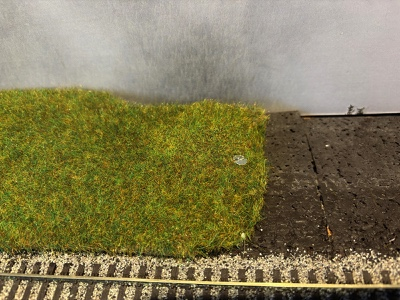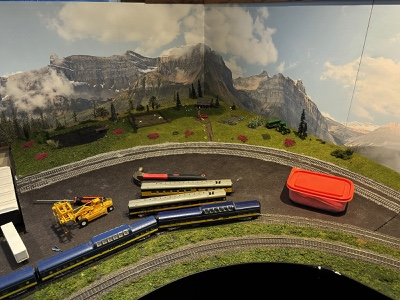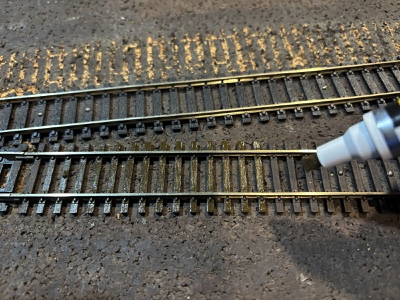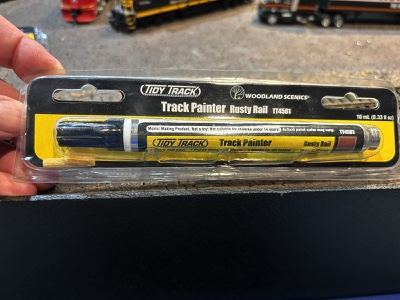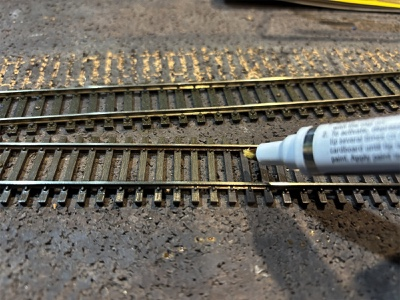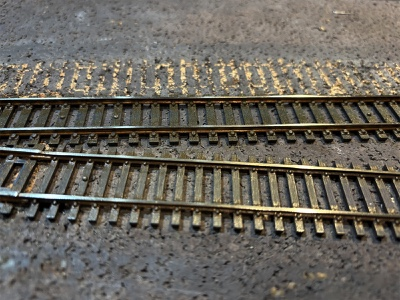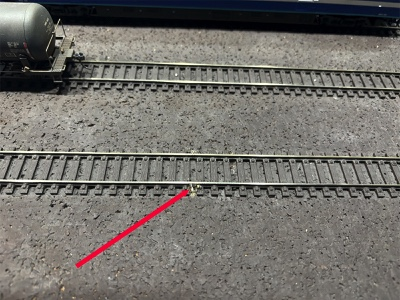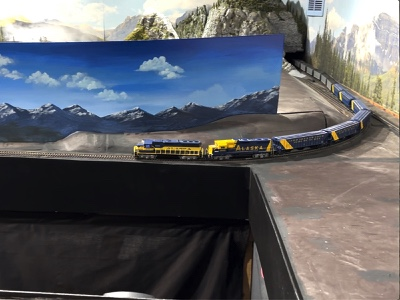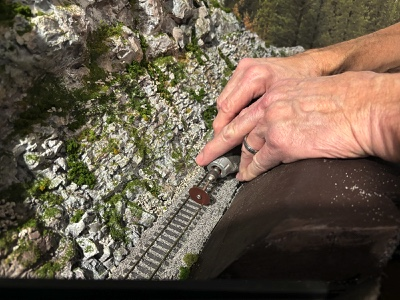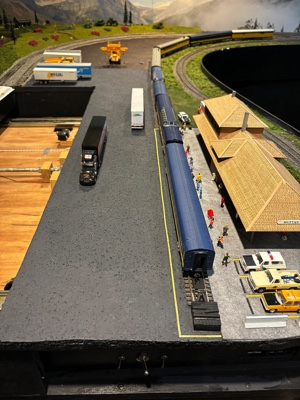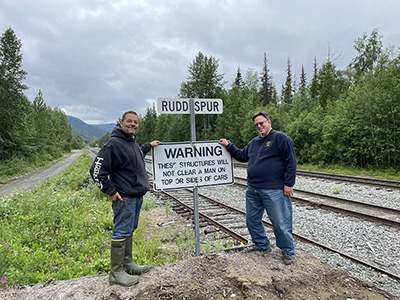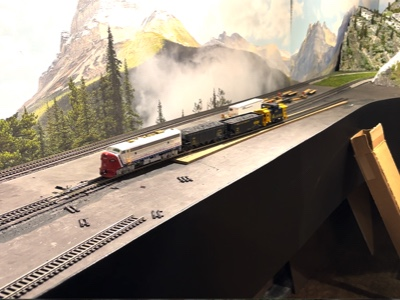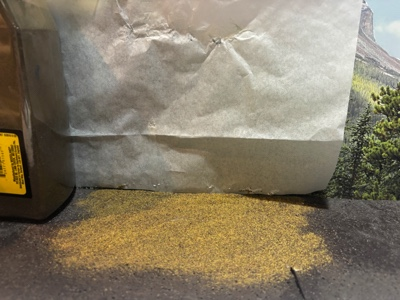
|
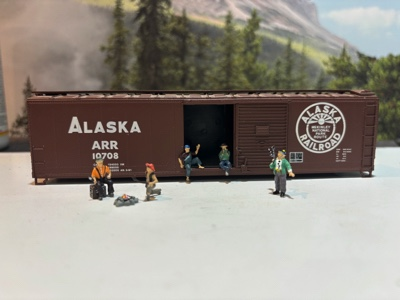
|
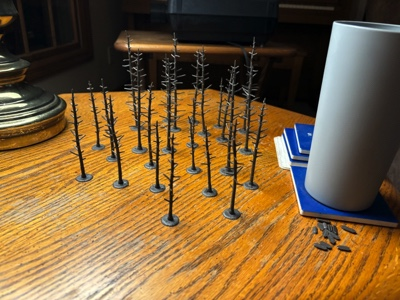
|
Continuing work to the south of Terry's cabin, John began preparations for a new scene. He mixed the dirt from his yard with Woodland Scenics Blended Turf Earth Blend T50 and glued it onto the cork board. Parchment paper protected the backdrop from glue or scenery material. |
John used a bit of his Christmas money from mother-in-law Jan Reynolds to purchase Woodland Scenics A1860 HO Scale Hobos Scenic Accents. He also went through the storage boxes and found this 54' boxcar with the McKinley National Park Route logo. This was perfect to use as an abandoned box car. |
Using more of his Christmas money from Jan, John bought the Woodland Scenics Realistic Tree Kit TR1113 containing 24 Pines, 2½ in - 6 in tall. Step 1: Bend and twist Tree Armatures into a realistic, three-dimensional shape. |
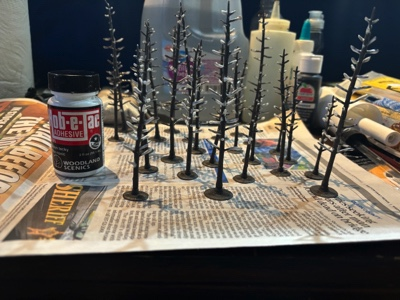 |
 |
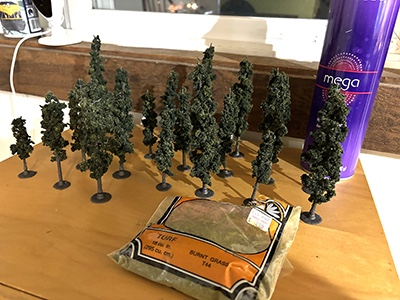 |
Step 2: Liberally apply Hob-e-Tac (S195, not included) to the branches. Although this step takes steady hands, some parts of the tree trunks accidentally received adhesive. John didn't seem to care about this problem and ultimately discovered it really didn't matter much. |
Step 3: Shred the foliage into smaller pieces. The directions didn't indicate final size, but twice the size of a BB seemed to work. The Hob-e-Tac needed to dry about 45 minutes before applying the foliage. John spun the trees as he dropped foliage. He picked off any excess. | Step 4: John sprayed the trees with hair spray and applied Woodland Scenics Burnt Grass T44 as a highlight. |
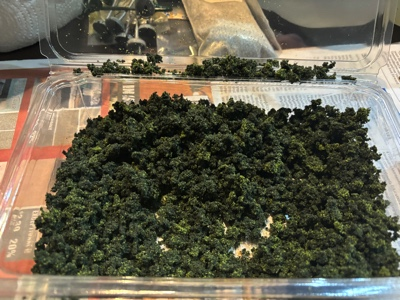 |
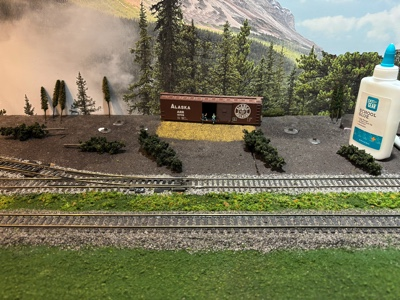 |
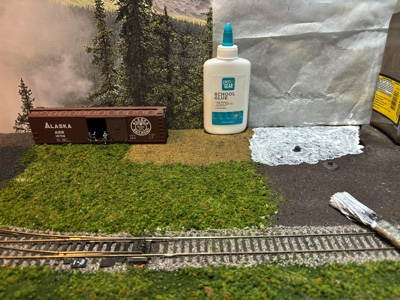 |
| Initially, John was concerned if enough foliage material was provided. However, there was more than enough with plenty left over for use on other projects. | Terry determined placement for the trees. The Woodland Scenics trees would be in the front. Since Jackie/John's pine trees were smaller, they were placed in the background. John glued the tree trunks into place. | Next, John applied Modge Podge followed by an application of Scenic Express Super Turf Ground Cover (tundra). Once this is dry, John will apply watered down Modge Podge to the entire area to secure all material. |
 |
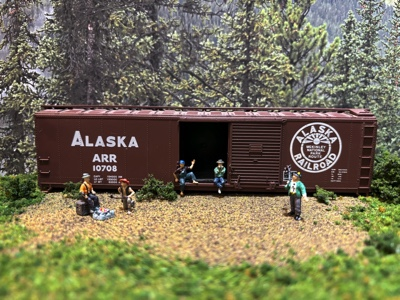 |
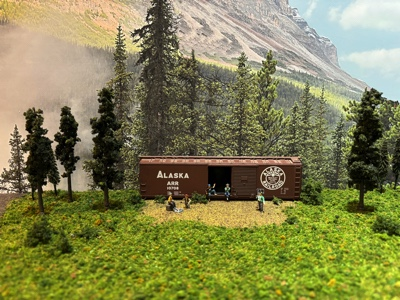
|
| All turf, trees and hobos are now in place. Over time additional scenic materials will be added. | Hobos Bird Eye Nick and Witch Dunagan cook their dinner over the fire. Boxcar Willie waves from the door of the boxcar while Popper John imitates the long, lonesome sound of a train whistle on his harmonica. At right, Hobo (and future multi-millionaire) Monte Holm arrives on the scene. | One more view of the hobo scene. |
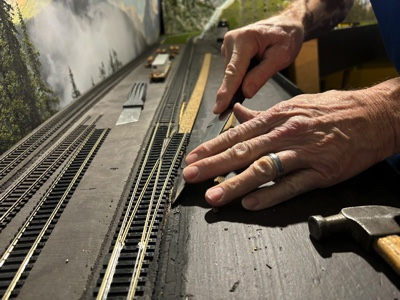
|
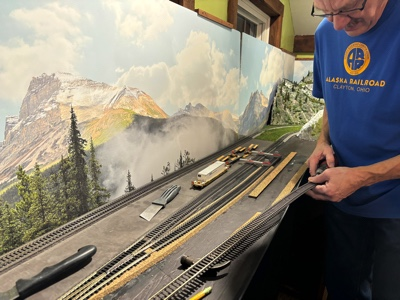 |
 |
| Tonight, Rick will finish up his work on Rudd Spur. First, he cut cork road bed for the spur. The cut angle is very important as it ensures a proper fit and no additional fill material will be required. John started the effort, but did a poor job. Fortunately, Rick, and his big knife, were able to make it all come out right. | Rick secured the cork bed to the foam board using rubber cement. The 15 minute drying time allowed repositioning if necessary. Next, he laid the flex track on top of the cork bed. More flex track was needed, so Rick grabbed some loose track next to the Anchorage yard. Using a Dremel, he cut it to the proper length. | To ensure proper track positioning, Rick used a Bachmann Adjustable Parallel Track Tool (two silver bars in the distance). The spur was perfectly placed and will provide "smooth as glass" operation. |
 |
 |
 |
| This turnout will not be operated remotely by the RailPro system, but instead by Caboose Industries sprung ground throw. Rick used leftover cork to create a base for the throw. | Rudd Spur work is now complete. All that remains is track painting and ballasting plus ground scenery material and sign boards. | Video: Rick ran the bicentennial locomotive and two North to the Future boxcars to test out the operation of Rudd Spur. Operation was indeed "smooth as glass!" |

|
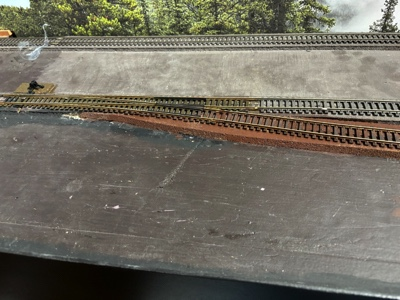
|
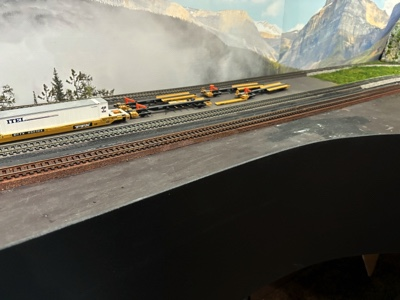
|
It's time to elevate Rudd Spur to the next level and add some realistic detail. John used Woodland Scenics Weathered Wooden Tie and Rusty Rail Track Painters. The cork track bed was painted with Apple Barrel Burnt Umber paint. Afterward, the top of the rails are cleaned by rubbing them with a Styrofoam block. |
Extreme care was used when working around the high speed turnout as paint and glue can gum up operation. The switch stand for the turnout was painted with the Woodland Scenics wooden tie painter.. |
The end result looks good! Although the colors seemed to be too pronounced, ballast will tone them down a bit. |
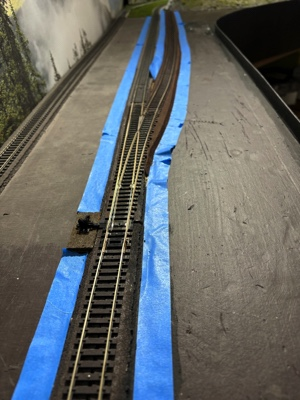 |
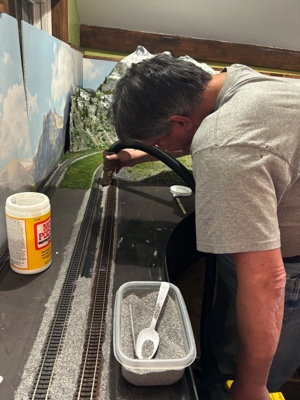 |
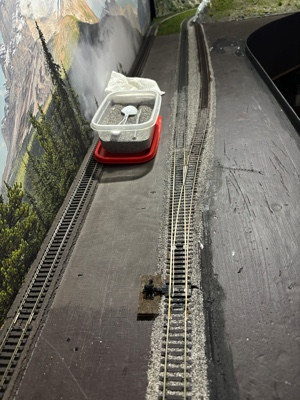 |
John placed painters tape next to the base of the cork road bed to prevent glue from getting onto the surrounding area. |
Next, Modge Podge was brushed onto the angled profile of the cork road bed. The painters tape was removed and then ballast added to the angled profile. After the ballast dried, the excess was vacuumed up and reclaimed. | Next, ballast was applied to areas between the ties, first in the middle and then the outsides. A total of six passes were made for both lines, each one placing an exact amount of ballast between the ties. |
 |
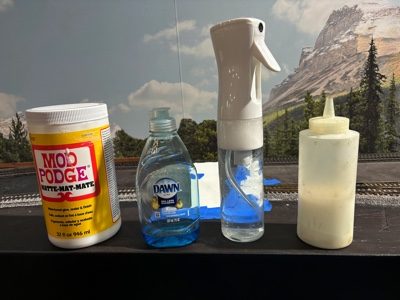 |
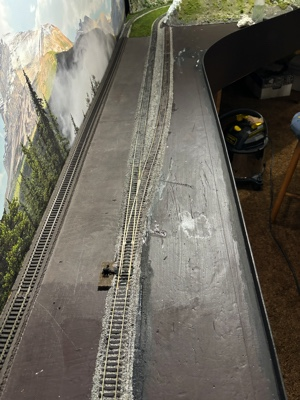 |
| John's next step was to apply wet water and glue. The turnout was covered to prevent anything from getting into the working mechanism. | Tools of the trade: Modge Podge was used as glue as it tended to dry clear. A mist sprayer applied the wet water (water with a squirt of dish soap). The Tom Koole condiment bottle contained a 50/50 mix of Modge Podge and water. | First, wet water was sprayed thoroughly onto the ballast. Next, the 50/50 Modge Podge mix was squirted over the ballast between and outside the rails. Finally, a fan was placed nearby to help everything dry quickly. |
 |
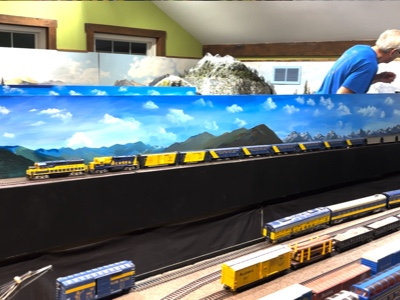 |
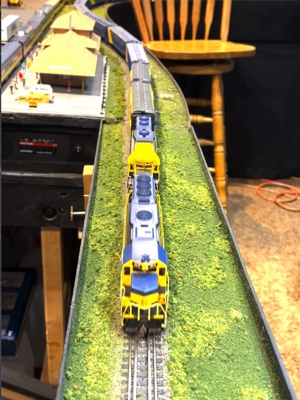
|
| The train night meal celebrated John's 64th birthday. Hors d'oeuvre of cheese and crackers and shrimp cocktail were served along with Jackie's world famous salad bar. The main course was chicken strips, with optional Chick-fil-A sauce, and fresh cut French fries. Of course, dessert was carrot cake! | Video: Rick ran a colorful 30-car consist, headed up by GP40 #3007 and GP38 #2005, through TwentyMile. | Video: Here was the 30-car consist as it passed Whittier and crossed the swing gate. Rick continued attempting to track down the power drop issues. |
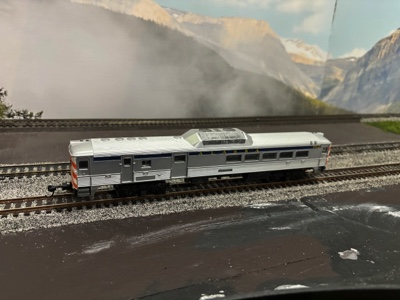
|
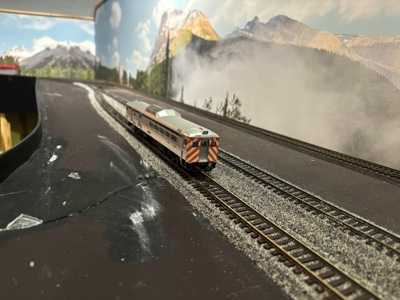 |

|
| We asked retired Alaska Railroad Trainmaster Curt Rudd what was his favorite locomotive. He said he enjoyed riding the RDC, as he and his sons were able to get up front, and watch the scenery from the windshield. Rick brought in the unpowered RDC to pose at Rudd Spur. The rubber band drive was no longer operational so we will watch eBay for a conversion kit. | The RDC at Rudd Spur. | Video: The front of the colorful Alaska Railroad consist barely cleared the caboose at the double crossover. Engineer Rick always handles the proper switching with skill and moxie. |
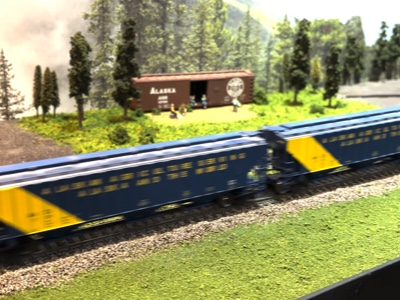
|
 |
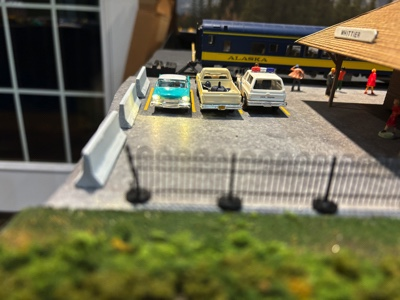 |
| Video: The colorful Alaska Railroad consist passed the hobo camp near Eppley Curve. Boxcar Willie gave the crew a friendly wave. | Rick installed Woodland Scenics Fancy Fins 1960's era coupe at the Whittier Depot. This coupe worked with the existing Woodland Scenics Just Plug system. It has working head and tail lights. | The brightness of the lights are set by a dimmer dial. This was a fun way of spending a little of my Christmas present money from mother-in-law Jan. |

|
 |
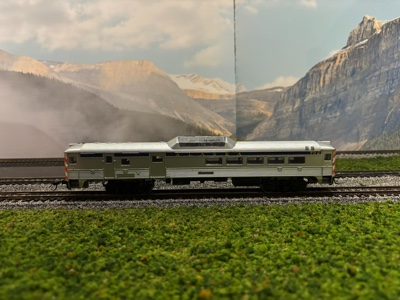 |
| John spent part of train night installing tundra cover surrounding Rudd Spur. He still has a long way to go to fill in the entire area. | RDC at Rudd Spur. | RDC at Rudd Spur. |

|
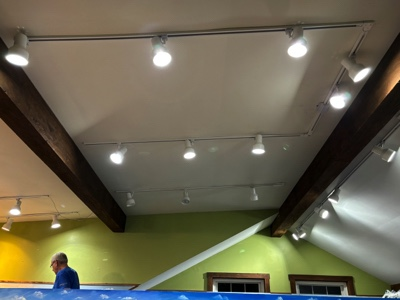
|

|
John thought he'd give Temu a try. He heard they were sketchy so he thought he'd give them a gentle air test. As it turned out, the shipping was free and tracking was great. As for the merchandise: The grass tuffs and static grass were very good. The people and animals were fine, but nothing spectacular. The flowers were smashed so John will have to revive them. He was satisfied enough to consider creating a second order. |
One of the LED ceiling track lights decided to go belly up. The bulbs were touted to last forever so what the heck is going on? |
Rick hopped up on a step stool and touched the middle light fixture. The whole strip came back to life. Rick had the magic touch! Apparently, ghosts turned the light housing slightly on the middle unit and this shorted out the entire strip. Pffftttt! |
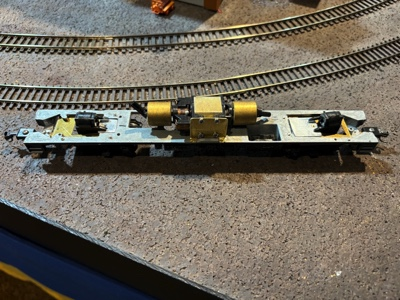
|
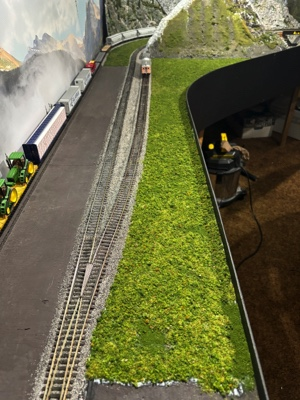
|

|
Rick had an idea to get the RDC up and running again (reference assembly instructions diagram). Instead of mounting the motor upright, he would turn it on its side, securing it in place with a metal L bracket. This would result in the drive shafts (11717) having less movement. He would then install a tube over the shaft couplings (90103 and 90108) to shore things up. If all else fails, we will turn to eBay and buy a motored (i.e. non-rubber band drive) RDC and adapt the existing shell. This shell was custom painted by Rick over 25 years ago. |
John continued to work on the scenery surrounding Rudd Spur. | Video: A big sky and dramatic clouds are the perfect backdrop for a pair of F7s heading south with a partially loaded freight train. In the middle of the backdrop is Mount Susitna, also known as Sleeping Lady. The mountain is associated with a legend in which a woman belonging to a race of giants vows to sleep until her beloved comes back from battle. |

|
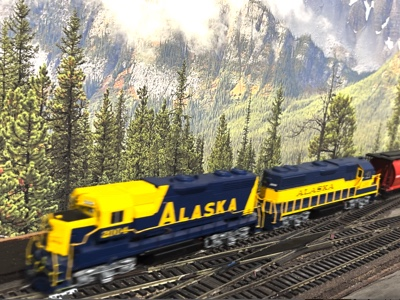 |
 |
| Video: Rick has become quite the RailPro Master. This video captured the crossing of two freight trains. The lower train will continue on through the tunnel, exiting at the double crossover where Rick will have it reverse directions, with the front and rear of the train clearing by inches. | Video: A freight train skirts the southern limits of the railroad at the double crossover. | Video: Maintenance of Way crews cleared an avalanche just in time for a freight to move through the cut and continue onward to the Port of Whittier. Local rock climbers exhibit both strength and dexterity as they make their way up Mount Denali, unconcerned with the passing train. |
